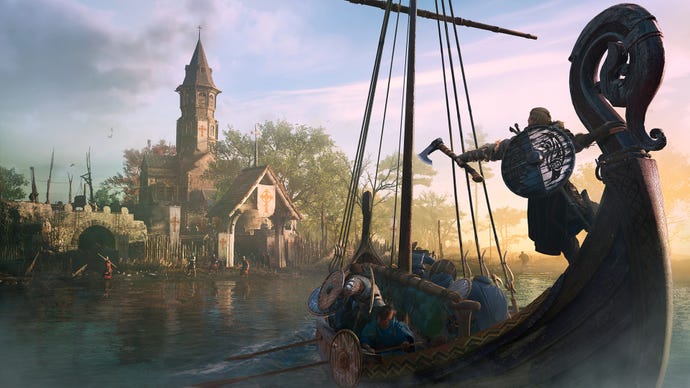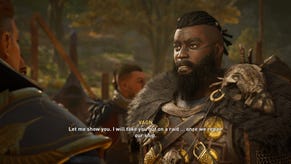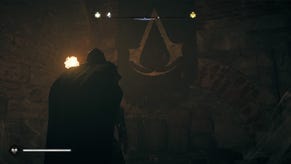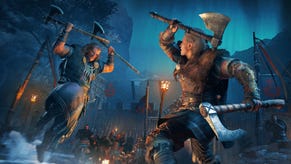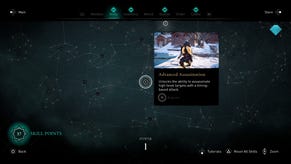Assassin's Creed Valhalla Hands-On: A Flatter Earth, Dual Wielding, Raids, And All The Other Big Changes
Valhalla stands as a mid-point between the previous RPG-focused Assassin's Creed titles.
This article first appeared on USgamer, a partner publication of VG247. Some content, such as this article, has been migrated to VG247 for posterity after USgamer's closure - but it has not been edited or further vetted by the VG247 team.
Two games in, Assassin's Creed has settled into a new rhythm, becoming an action-adventure game that leans heavily on role-playing game ideas. With Assassin's Creed Valhalla, the series is heading to medieval England to highlight the conflict between the Danes (the Vikings) and Saxons during the first Viking invasion of England. In Valhalla, players will step into the fur boots of Eivor, a warrior who finds themselves turned to the Assassin cause.
After two cinematic trailers and a host of interviews, I'm finally getting a chance to see how Assassin's Creed Valhalla plays. Ubisoft's demo drops me into what feels like the middle of the game: it's 873 CE and Eivor is bringing together the Danes and Saxons to fight against Rued, a bloodthirsty Viking warrior who has killed Oswald, a Saxon regent that wants both peoples to co-exist.
I'm tossed into the deep end, with little narrative context. Is Eivor and their crew on the side of the larger Danish invasion with Rued as an outlier? How did Eivor come to get the not-so-Hidden Blade, and are they firmly with the Brotherhood at this point? Those are questions for another time, I suppose.

England Is Pretty Flat
In a previous article about Assassin's Creed Valhalla, I speculated that this entry would hew closer to Assassin's Creed 3 in landscape. AC 3 took place during the Colonial era in North America, with a host of decent port cities and a whole lot of wilderness. Given the time period, I expected that Valhalla would be the same, and I was mostly correct.
My demo took place in East Anglia, a chunk of the overall game and what looks to be one of the smaller regions overall. There were the fishing villages of Elmenham and Thetford, and the larger city of Northwic, which was closer to the smaller towns within Assassin's Creed Odyssey. Larger cities like London, Winchester, and Jórvík are to the North and Southwest. Unfortunately, the demo had a huge Animus wall preventing us from leaving East Anglia. The rest of the region was ruins and wilderness; not devoid of things to do, but less stuff to climb on.
There have been comparisons of Valhalla to CD Projekt Red's The Witcher 3, and while the gameplay is different, the visual comparison is strong. Riding your horse through a small farm as the sun begins to set evokes the same feeling. There are even pockets of the region that lean into a more magical feel, like a ritual site full of wicker effigies where I had to destroy a Cursed Symbol to cleanse the region, or fight against the shamanistic seidr Regan, who wields magical flame powers and teleports. It's clear the "magic" part of the seidr fight is the result of a hallucinogenic drug that you breathe in, but it's not entirely leaving behind the idea of magic as a whole.
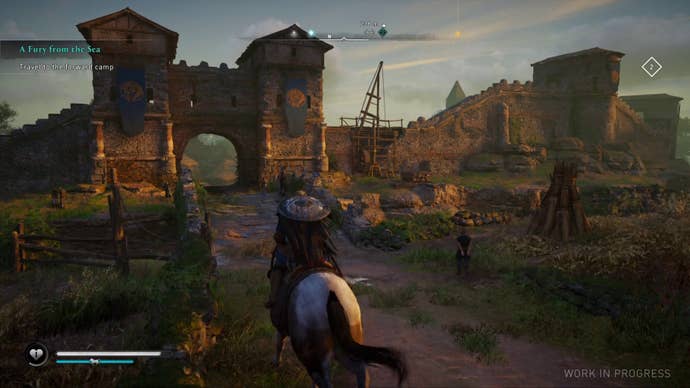
Assassin's Creed has usually been a very urban game, as the art of parkour is a city-based pastime. It's the province of alleyways and rooftops. Black Flag, Origins, and Odyssey had less of that due to their time period and environments, but made sure to offer several massive cities to circle back on the familiar Assassin's Creed feel. Valhalla could have that in spades in the final game, but it was not apparent in the demo. I would've liked to see a bigger city in this demo, so my mental jury is currently still out on the verticality of Assassin's Creed Valhalla.
One weird change has been a slight pullback in the ability to climb anywhere. Odyssey simply let you climb anything in your way and the game would work out your path. Valhalla is most of the way there, but there were outcroppings and overhangs where Eivor would just wait for me to choose the right way forward, like the older Assassin's Creed titles. Alexios and Kassandra would always figure it out, while Eivor occasionally gets stuck. I'm also a bit perplexed that there wasn't more tree parkour, a la Assassin's Creed 3. You can climb some trees, but I wasn't able to easily work out the path to the top of the available trees.
Instead, you'll more likely get around on your horse, or ride the waterways with your Viking crew. Like a lot of the things I'm going to cover about Valhalla, the longship splits the difference between Origins and Odyssey. It's not the one-man boats of Origins, but it's also not the full ocean-bound ship from Odyssey. You can call your ship from any river and they'll come sailing up, ready to go. Like Black Flag, you can set your Skald (the Norse version of a poet), Bragi, to singing, or have someone tell a cool Viking tale; these were prompts in the demo, though there was no actual singing, just a single jaunty tune playing. The rivers themselves are pretty small though, close to the canals of Origins.
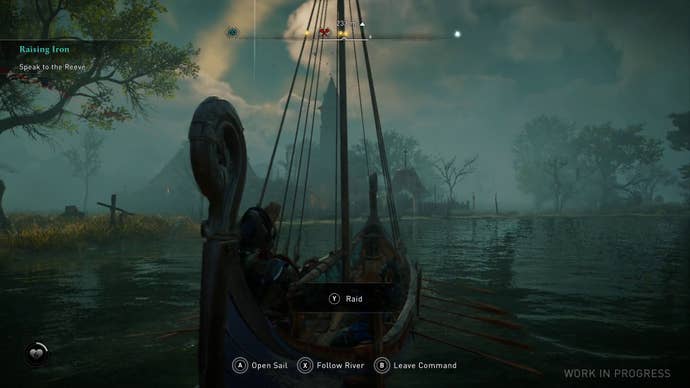
This is My Raid Group
While Eivor still does the climbing and sneaking thing, Valhalla has two different types of larger group combat situations. Raiding is done on English outposts along the various rivers; as you ride up to an outpost, you'll get a prompt to bring a raid. This sees Eivor and their crew rush forward into the outpost to be met by opposing guards.
The system is probably closest to Assassin's Creed: Black Flag's forts, where these outposts have either physical locations you need to burn, targets you need to kill, and treasure that has to be looted. You can aid your forces by killing soldiers on the ground, but I found you're more helpful by taking out archers or soldiers manning cauldrons of burning pitch.
There's also a bit of tactics. Doors to certain buildings are locked, requiring you to find the key, wait for your crew to get freed up and bash the door down with you, or find an alternate way in. In a raid on Beodericsworth, I had run far ahead of my warriors and I didn't have a key, so instead I climbed around the locked chapel looking for a way in. I eventually found a stained glass window that I broke to gain entry. I couldn't loot the chest alone, as the lid was too heavy, so I quietly assassinated the guards waiting at the front door, and then opened it to give my warriors access. That whole sequence felt pretty awesome, with more complexity than Black Flag's "find the captain" objectives in forts.
Alternatively, you can do the sneaky assassin thing. In the town of King's Bury, I tried both the aggressive raid, and the stealthy infiltration. I rode near the outpost with my crew, then I dove into the water and swam around the backside of the main building. Then I worked my way through the guards, using environmental traps and assassinations to clean up. The latter takes a longer period of time, and I'm not sure you get anything more, but it's your choice how you want to play in Valhalla.
The climatic capper to the demo was an Assault on Rued's fortress. Assaults are clearly meant to be more cinematic, with a full intro playing up the epic nature of the conflict: Eivor's army of Danes and Saxons on the high sea in a storm, lightning flashing in the sky and flaming arrows raining down on the amassed ships. One ship full of explosives rams into the fortress wall, blowing it open and beginning the Assault.
Assaults work like the aforementioned raids, but you need to use a ram to break through various doors within the fortress. You can let your warriors do the ramming, or hop in with Eivor and take direct control. Following a forceful entry through three areas of the keep, I fought Rued's lieutenants, before parkouring my way around to Rued himself.
There's more impact to raids and Assaults than Odyssey's previous Conquest Battles, which were only combat free-for-alls. Here, you at least have soft objectives and choices to push your offensive forward. Figuring out how you're going to get into a locked keep to get at all that treasure feels meaningful in the moment. Which is to say, hey, this is an improvement over the large-scale combat that's come to the series before in Black Flag and Odyssey.
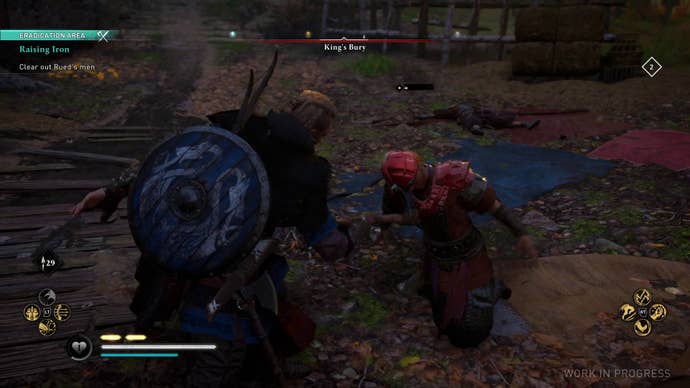
Same Systems, New Tweaks
If you were expecting a full overhaul of what Assassin's Creed currently is in Valhalla, I'd say this is not what you're looking for. This is a tweak of what came before, adding mechanics, changing others, and slightly changing the controls.
Take combat. It's still the same dodge and attack gameplay from Origins and Odyssey. There's slightly more weight in the animations, and the developer has hinted that there's some hitstop during melee combat, but it doesn't really feel vastly different. (There is blood spatter and dismemberment this time around, so that does add some visual impact.)
What has changed is in regards to dual wielding. Now the right and left bumpers control attacks with your right and left hands. Right bumper is your light attack with your right hand weapon, Right trigger is the heavy attack with that same weapon, similar to Origins and Odyssey. The left bumper is where it gets a little interesting: If you have a shield in your left hand—yes, it can be equipped in your right hand and be used to attack—tapping the button brings up your shield to parry, and holding it blocks, similar to Bayek in Origins. If you have a weapon in your left hand, tapping the bumper parries and holding the button does a combination attack. If you don't need the defensive capabilities of blocking and can get by on parrying, you gain more offensive power.

Parrying and heavy attacks chip away at enemies' stun meter, which sits above their health bar. (Blocking does not seem to affect the stun meter.) Once normal enemies are stunned, they get opened up to Stun Attacks, which are instant kill moves based on what you or your enemies have equipped. There's also a little dismemberment in Valhalla now; I hit a guy with a flail and watched his head pop right off.
There's also a skill that lets you swap which weapon is in which hand while dual-wielding by double-tapping A, letting you switch between, say, an axe and a flail as your primary method of attack. It's another series of options in combat. Not an overhaul, but bringing together blocking and parrying works once you wrap your mind around it.
Other changes include moving Assassination to the left bumper, meaning once you enter open combat, you can't assassinate at all, because tapping the bumper is your light attack. This was a change I immediately turned my nose up at, but I quickly got used to it. There's some fuzziness in the moment where you're about to assassinate and someone sees you, but that's always been in Assassin's Creed.
As promised, there's a skill that allows you to one-hit assassinate targets that would otherwise be a critical hit. When you assassinate a higher-level target with the skill active, you're presented with a timed mini-game where you have to press the button again within a certain window. The thing is, the timing is fairly open, making it very easy to land the hit; I assume this was for the demo, because as it stands I never missed. If it's going to remain as simple in the final version, I'd almost rather they take it out and just let it be a one-hit kill.

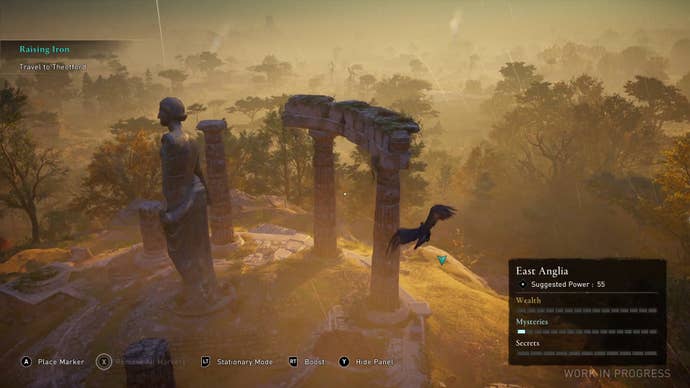
Conquering New Territory
There is some difficulty present in scouting though. You can still scout from high above with Eivor's raven, but while the raven sees locations and enemies, it no longer marks enemies. Instead, the Animus Pulse from Origins returns. With the newly-named Odin Sight, you click L3 to do a quick vision pulse which marks enemies in a hazy red (not the clear outlines of previous games) and lootable items in white with an audible ping.
The change makes it so you're not always entirely sure what's around the corner. I'm not sure if there are skills that improve the Odin Sight mechanic or lets the raven tag targets again, as the skill trees were largely locked in the demo.
Abilities and Skills are also broken out into different sections in Valhalla. Abilities, the active attacks you access by holding the Left or Right Triggers, are now found in the world in Books of Knowledge. These are found in raids, ruins, and in secret locations, driving you to explore more of the world Valhalla has to offer. And you level these abilities by finding more of the same book.
Skills are more passive abilities and bonuses, slotting into Raven, Wolf, and Bear categories. Raven is the assassination tree, with abilities like Backstab, Advanced Assassination, and Chain Assassination. The Bear is the combat tree, with the previously-mentioned Dual Swap and stunned Stomp attack. Finally, Wolf looks to be concerned with the bow, such as its Emergency Aim, which slows down time for a quick headshot when an enemy spots you.
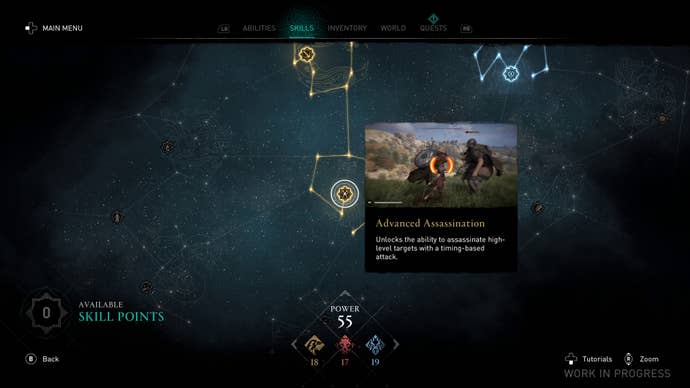
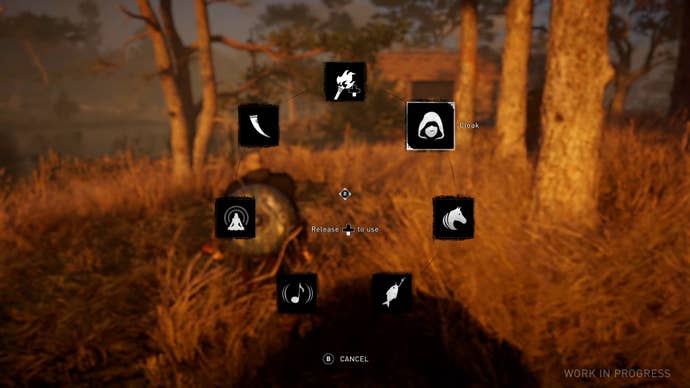
Dropping skill points into each of these trees increases your power in the three categories, benefitting both gear and overall power, which seems to replace hard levels in Valhalla. That's right—the controversial leveling system is roughly gone. Regions do have recommended power levels, but there's no indication as to whether that'll make it impossible to tackle higher-leveled regions.
There is also a host of side abilities that appear if you hold down on the directional pad. A wheel has all of these actions: Pull Out Torch (unlit), Toggle Hood, Call Horse, Fish, Whistle, Meditate, and Call Longship. Releasing the d-pad on a selected action performs it, and sets that action as the quick action when you tap down. The toggle hood abilities seem to be used for social stealth in cities, but I was unable to parse that during my demo. I did fish however and… fishing is fishing. It's fine.
One great change is in healing. Eivor now has rations, a limited resource for healing. By picking up berries in the wild and food in towns, you'll fill up a small ration meter in the corner of the user interface. When it's full (three or four berries in my case), you get a single ration. Tapping left on the d-pad uses that ration to heal you. It altogether adds a little more of a challenge than Odyssey's adrenaline-fueled heal, such as the revelation I had mid-demo when I walked into a boss fight without realizing I had used all my rations.
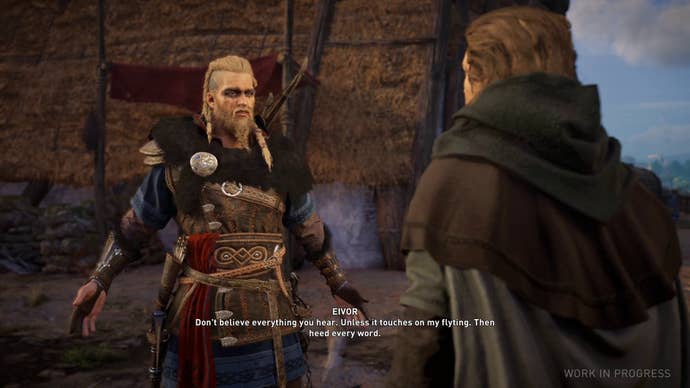
A Puzzling Addition
There are also a host of smaller puzzle events around the world. There's the Cairn, a physics-based puzzle where you stack rocks to a certain height. The trick is that the rocks can and will fall over if you don't stack them properly. It's building a medieval Jenga tower.
Traversal puzzles also return in Valhalla. Animus Anomalies freeze the world when you touch them, kicking you back into the body of Layla. She's looking like she's been through better days and talking to someone named Bec. (Perhaps, Rebecca Crane from the earlier Assassin's Creed games?) These puzzles have Layla climbing through an obstacle course of glowing blocks in the sky. It's… very weird. I'm glad to see traversal puzzles return to Assassin's Creed, even if this isn't quite the skill and timing-based puzzles that were a holdover from Prince of Persia. Still, it's a great addition to the side quest canon and I look forward to seeing more.
Finally, there's Flyting, the art of ancient rap battle. To be honest, it needed a little more pomp and circumstance. Maybe some music. The only example in the demo is a back and forth battle of wordplay. Your opponent offers up one line, and you have a limited time to pick between three responses, with the aim to find the one that rhymes while also playing up your stature. It was pretty easy, and winning the battle saw me leveling up my Charisma, which seems to be a brand-new system altogether.
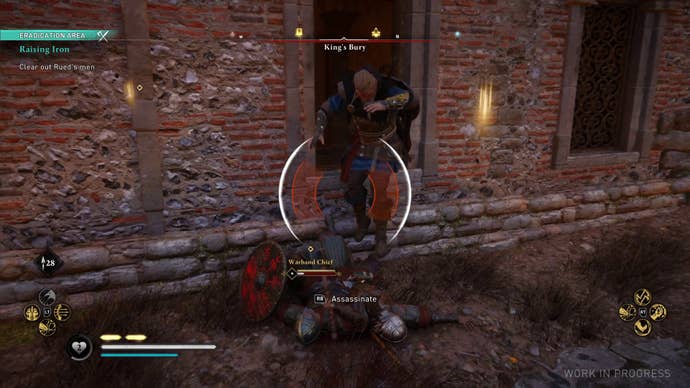
This demo was a mechanical one, built to show me where Assassin's Creed generally stands in 2020. But it was missing the context I needed to understand who Eivor truly was and the impetus of their actions. I'm certain that's something further demos and previews will get into ahead of launch, but it was noticeably missing here.
Walking away from my three-hour demo, I largely felt like Assassin's Creed Valhalla is a continuation of what came before. Origins was a new start for the series, and Odyssey took that idea further afield. Valhalla seems like the Origins team trying to pull back a bit, while also tweaking certain mechanics. It's the continuation (or end?) of a generation of Assassin's Creed, rather than the start of a new one. If you liked Origins and Odyssey, Valhalla is shaping up to be the ur-version of that concept.
But I admit that I walked away from my paired demos of Assassin's Creed Valhalla and Watch Dogs: Legion seeing the latter as the vanguard of more "new" ideas. It's still clearly well done, but this isn't the teardown year for Assassin's Creed. Perhaps that comes next, when this trilogy is done.
Assassin's Creed Valhalla is coming to PC, PlayStation 4, PlayStation 5, Xbox One, and Xbox Series X on November 17, 2020.
